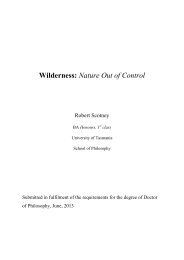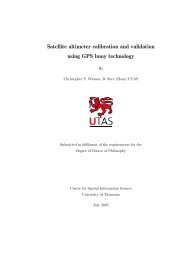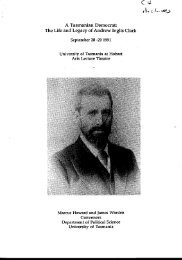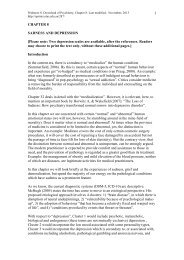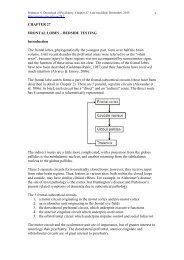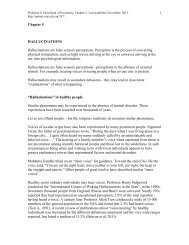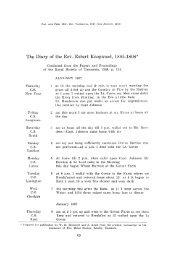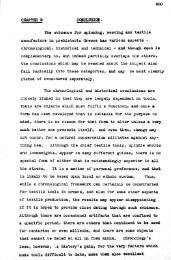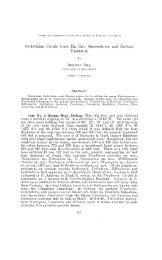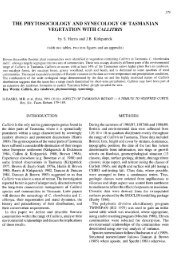PDF (Front matter) - UTas ePrints - University of Tasmania
PDF (Front matter) - UTas ePrints - University of Tasmania
PDF (Front matter) - UTas ePrints - University of Tasmania
Create successful ePaper yourself
Turn your PDF publications into a flip-book with our unique Google optimized e-Paper software.
,<br />
THE EFFECT OF TRANSPORTA nON ON JEWISH CONVICTS IN<br />
VAN DIEMEN'S LAND.<br />
by<br />
Nachuma Rivkah Kelly.<br />
Submitted in partial fulfilment <strong>of</strong> the requirements for the degree <strong>of</strong><br />
Bachelor <strong>of</strong> Arts with Honours<br />
<strong>University</strong> <strong>of</strong> <strong>Tasmania</strong><br />
Hobart<br />
1994
Contents<br />
Introduction 1<br />
Chapter one: Anglo Jewish history 3<br />
Chapter two: Public and "Private attitudes inVan Oiemen's Land 9<br />
Chapter three: The Effect <strong>of</strong> Transportation. 17<br />
.<br />
",.<br />
U ,<br />
Chapter four: Intermarriage, Assimilation and Isolation. 26<br />
Chapter five: Focus on Individuals. 30 •<br />
I<br />
Chapter six: The Female Convicts.<br />
Conclusion 39<br />
Appendix<br />
Bibliography<br />
33<br />
,<br />
...
1<br />
Introduction<br />
The history <strong>of</strong> the Jewish convicts in Van Diemen's Land is one that<br />
provides the researcher with a wide area to consider. The most important<br />
question however would be , what effect did transportation have on the Jewish<br />
convict? Was their sense <strong>of</strong> identity overwhelmed by the artificial Christian<br />
emphasis '<strong>of</strong>fered' by colonial penal society? The evidence perhaps in most cases<br />
would suggest that assimilation, induced by environmental factors was the end<br />
result <strong>of</strong> transportation.<br />
There were at least two hundred convicts transported to Van Diemens<br />
Land who can be easily identified as been Jewish, with a further one hundred<br />
possessing the 'characteristics' <strong>of</strong> the Jewish convicts (that is , names, aliases,<br />
places <strong>of</strong> birth and trades.) lThe majority were under thirty, unmarried 2 and<br />
from the poorer districts <strong>of</strong> London. Their exposure to their religion would have<br />
been limited (having no wives and children <strong>of</strong> their own) even though the<br />
majority were from an Ashkenazi / Orthodox - traditional background. They<br />
were exiled mostly for non-violent crimes. Receiving stolen goods, picking<br />
pockets and housebreaking/shop stealing were common crimes amongst the<br />
Jewish convicts.<br />
The unusual crimes included a courtmartial for desertion (Levy<br />
Frankland), 3 wilfully setting fire to premises (Harris Rosenberg), 4 forging<br />
Russian banknotes (Jacob Friedeberg)5 and a highway robbery in Christchurch,<br />
Middlesex (Solomon Lyons).6 Several convicts were re-sentenced to death for a<br />
second crime in Van" Diemens Land whilst many were sent to Norfolk Island,<br />
Macquarie Island, Port Arthur, New South Wales and other places <strong>of</strong> secondary<br />
punishment. Jewish convicts were stationed on the remote probation stations,<br />
such as Wedge Bay as well as the major towns. This displacement helped to<br />
contribute to their sense <strong>of</strong> isolation. The Majority <strong>of</strong>.convicts if they married,<br />
married out <strong>of</strong> the faith and several converted to Christianity. Many children<br />
born to convict women (and men) were inevitably baptised.<br />
Those convicts lucky to have family in Van Diemen's Land or whom were<br />
married to Jewish women before being transported were the convicts most likely<br />
to survive as Jews, religiously and ethnically. It was this vital connection to their<br />
identity that most Jewish convicts lacked. Those that intermarried usually<br />
lexpanded in appendix 1.<br />
2 see appendix 2.<br />
3CON14/30<br />
4c:on33/36<br />
5CON33/98<br />
6CON17/2
2<br />
became less involved with the community perhaps because <strong>of</strong> the guilt felt by<br />
marrying out <strong>of</strong> the faith, a practise rarely pursued in Jewish life. The<br />
Christianity <strong>of</strong> their spouses was <strong>of</strong>ten more acceptable to the mainstream than<br />
their own religion. All these factors combined to draw the Jewish convict<br />
unconsciously away from Judaism and to create a system <strong>of</strong> 'passive' genocide, a<br />
genocide initiated by government policy and the unique social environment <strong>of</strong><br />
Van Diemen's Land.<br />
The Jewish community that convicts encountered in Van Diemens Land<br />
from 1803 to the 1830's was very different from the one which they had left<br />
behind. What remained familiar were the attitudes <strong>of</strong> the Government and the<br />
public which resembled those <strong>of</strong> their counterparts in England, the only<br />
differences being the concentration and the focus on the perceived problems in<br />
such a small environment. The Jewish community, initially made up <strong>of</strong> convicts<br />
and emancipists did not possess the necessary framework to counter anti -<br />
semitic claims <strong>of</strong> the public or request what were seen as neccesary freedoms<br />
from the colonial government?<br />
It was not until the arrival <strong>of</strong> free Jewish settlers in the 1830's that the<br />
community became viable in Van Diemen's Land. Before this important<br />
development, the direction that the Jewish convict took would not neccesarily<br />
reflect his ethnic and religious past. To understand the response to<br />
transportation up to this point then, it is neccesary to look at the society which<br />
the Jewish convicts had come from and the society they entered. Without this<br />
knowledge we cannot possibility understand the psyche <strong>of</strong> the Jewish convict.<br />
7 Levi, J. & Bergman, G.P.J. Australian Genesis 1788-1850. Rigby, Adelaide, 1974. p.257. Levi<br />
claims that this was due to apathy and disinterest amongst the Jewish convicts and not the lack <strong>of</strong><br />
community framework.



